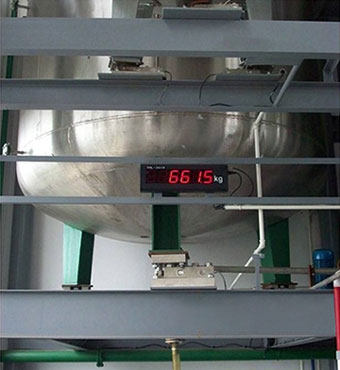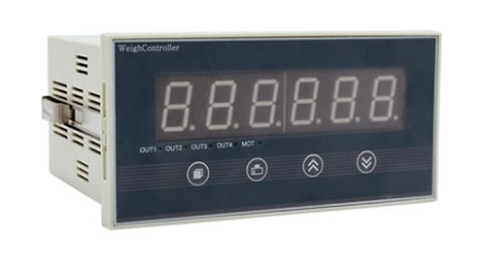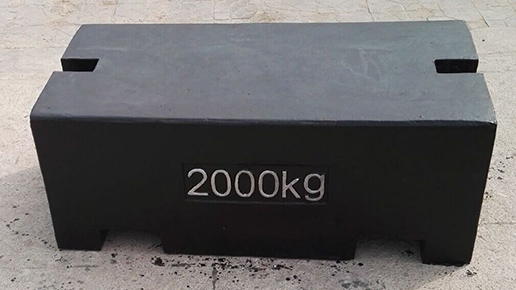Calibration of load cell and digital display controller
- Preparation before calibration
- Purpose and principle of calibration
- Calibration weight requirements
- Zero calibration
- Full range calibration
Preparation before calibration
After completing the wire connection and mechanical installation of load cell, the calibration of load cell and digital display controller can be continued.
It should be noted that no change is allowed on any equipment after calibration. If it is a tank, all pipes connecting with the weighed tank should be installed according to the required flexible connection. In case the weighed tank and pipes need heat preservation, the calibration should be started after the completion of heat preservation.
Purpose and principle of calibration
The calibration of load cell and digital display controller is mainly to confirm the weighing signal of zero point and full range of the load cell. That is to say, telling the digital display controller what are zero weight signal and full range weight signal received from the load cell.
In this way, the digital display controller will display value according to the detected weight, or export the matching weight signal to the PLC control system.
Calibration weight requirements
It is not realistic to add the exact quantity of measured materials to the weighted tank for calibration at the industrial site. Basically, we adopt means of hanging counterweights to the tank or a known exact weight of substitutes for calibration. Therefore, it is necessary to prepare the heavy objects in advance before calibration. And it's better for the weight of heavy objects to be equivalent of digital display controller upper limit value.
However, in many cases, there is no condition to prepare enough heavy objects, or there is not enough space for the weighed tank to place too many heavy objects for calibration in the scene, so we should consider comprehensively according to the scene conditions.
In general, the minimum weight for calibration should reach 30% of the upper limit of the digital display controller range. The higher the heavy objects are, the better the effect is.
When calibrating load cell sensor and digital display controller, zero calibration should be first, and then the full range calibration:
Zero calibration
In zero calibration, check the pipes connection once again and confirm that other devices connected with the weighed tank will not affect the measurement in zero calibration. After checking, all existing weight on the load cell is taken as zero weight, and the signal transmitted by load cell at this time is reserved as zero signal by the digital display controller.
The process of zero calibration is similar to net weight function of digital display controller. Both of them are to call the existing weight as zero weight. However, the net weight function is temporary. When the digital display controller is powered on again, the display value on the digital display controller will not remove the tare weight anymore. But if zero calibration is completed, the zero weight will still be shown when power on.

Full range calibration
There are several methods for the full range calibration of digital display controller, you can select according to scene condition:
Full range calibration with counterweights
This method has the highest accuracy of measurement after calibration. In the industrial scene, this method can be applied to smaller weighing capacity. But when the capacity is as large as 10 tons or 20 tons, there is no so many counterweights. Moreover, there is no enough space on the tank to place so many weights, and it is also possible for the tank or tank wall to bear the weight of such heavy weights.
Comprehensive calibration with counterweights and substitutes
This type of calibration is to divide the calibration of full range weight into several steps, and increase weight step by step until full range. First of all, 10-20% of counterweight is used for preliminary verification, and then water is used as a substitute to add into the tank in the later verification until full range. For example, for a tank with 10 tons full range, there is only 2 tons of counterweights for verification.
In this case, firstly adjust the digital display controller into this comprehensive calibration procedure:
- Step 1: Add 2 tons of counterweights, and then the digital display controller will show a weight value. Take down counterweights from the scale after confirmation and add water until the display value is the same as the display value of 2 tons of counterweights, now the load on the scale is 2 tons.
- Step 2: Add counterweights after confirmation again, and then the load on the balance is 4 tons after adding 2 tons of counterweights. Record the display value and take down counterweights after confirmation.
- Step 3: Add water once again until the display value is the same as the display value of 4 tons of counterweights. Add 2 tons of counterweights once more after confirmation......

In this way, step by step until the load on the scale is 10 tons, and complete calibration by confirming the completion of calibration procedure. This method requires water supply at the scene and water release after calibration. While adding water, the flow of water can be controlled so as to prevent halfway failure of calibration due to excessive adding at one time, then the calibration has to restart from the beginning. This calibration method also has good effect after completion.
Substitute calibration
This type of calibration is to move an object that has been weighed on the other scale into the tank as a standard weight, which is to substitute objects for counterweights actually. Steps for calibration should still be in accordance with the above two methods.
Electronic calibration
Electronic calibration refers to use a simulator to simulate the full range output signal of load cell, making it loaded on the digital display controller to implement calibration procedures. Many digital display controllers contain calibration-free procedure, its essence is also to calibrate by adopting fixed load cell output to correspond to the maximum range of weight.
After finishing calibration of load cell and digital display controller, production can be carried out directly. After a period of use, the upper limit of range on the digital display controller should be changed due to process reasons, a new calibration of load cell and digital display controller should be proceeded.
For load cell and digital display controller kit, ATO provides calibration service before them leaving our factory. For example, if you buy a 20-ton load cell and a digital display controller together. ATO will calibrate display controller full range as 20 tons or other weight you required.
Here is a simple video from ATO Automation. It's just about how to wire and calibrate load cell and load cell controller and how to set parameters of load cell controller.

